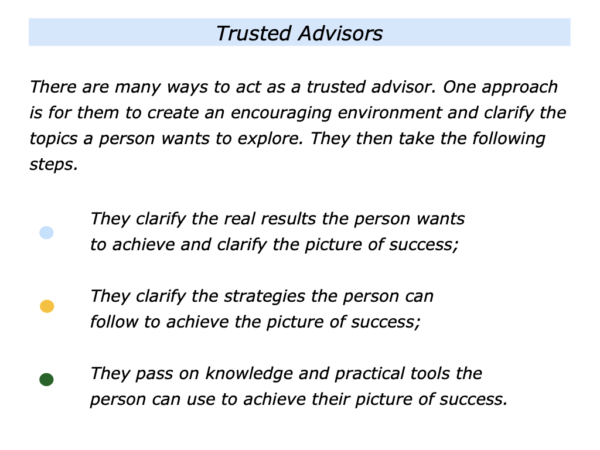
There are many ways to help people. One approach is to act as a trusted advisor. Different advisors have different kinds of expertise.
They may be good at helping people to shape their future lives, develop their careers, tackle business issues, deal with crises or find solutions to other challenges. One common theme, however, is that:
They use their knowledge to help people to achieve their picture of success.
This article is based on the workshops I used to run for organisations that wanted their people to act as trusted advisors.
If you wish, you can take the ideas you like from this article and use them in your own way to run such workshops. Here is the introduction to the workshop.
The Trusted Advisor Workshop
This workshop focuses on how people can build on their strengths and be good trusted advisors. It shows how they can use their knowledge to help their clients and their organisation to achieve ongoing success.
The workshop provides
practical tools that people can use:
To identify the qualities demonstrated by good trusted advisors;
To prepare properly for a session with a client and make sure they understand the person’s world;
To create a positive environment in which the person feels ease and able to explore their challenges;
To clarify the real results the person wants to achieve and translate these into a clear picture of success;
To use the Three C Model – focusing on Clarity, Creativity and Concrete Results – to help the person to achieve their goals;
To pass on knowledge in a way that the person can use to achieve their picture of success;
To continue to build good relationships that enable both the client and their own organisation to achieve ongoing success.
The workshop will be positive and practical. The session is best followed up by producing success stories. These are to show how people have used the principles to help both the clients and their own organisation to achieve success.
The following sections provide ideas you can adapt in your own way to run a workshop. The article also invites you to do some of the exercises that you can give to people. Let’s start by exploring the first theme.
The Qualities Demonstrated
By Trusted Advisors
Looking at your life and work, are there any times when you act as a trusted advisor to other people? You may take this role as a friend, educator, mentor, client manager, technical advisor, problem solver or other kind of professional.
There are many books on this topic. One of the most respected is The Trusted Advisor by David Maister, Charles Green and Robert Galford. They believe that such people earn their client’s trust by building good relationships and offering effective advice.
So how can you be a good trusted advisor? What are the qualities you can demonstrate to help people to feel valued? How can you then help them to achieve their goals?
One approach is to begin by looking at your own experiences. If you wish, try tackling the exercise on this theme called My Trusted Advisor.
Looking back on your life, can you think of a time when somebody acted as a trusted advisor for you? They may have been a friend, teacher, coach, mentor, doctor, lawyer or in some other role. What did they do right then to act as a trusted advisor? Try describing the following things.
Describe the person who acted as a trusted advisor for you.
Describe the specific things they did – the principles they followed – to act as a trusted advisor for you.
Here is the exercise on this topic. This is followed by a list of the common themes that emerge when people do this exercise.
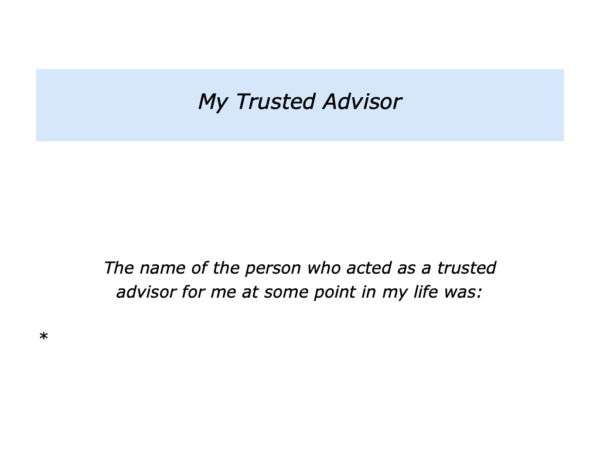
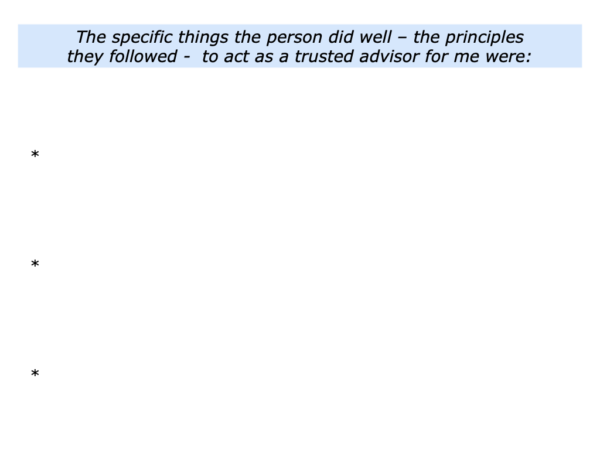
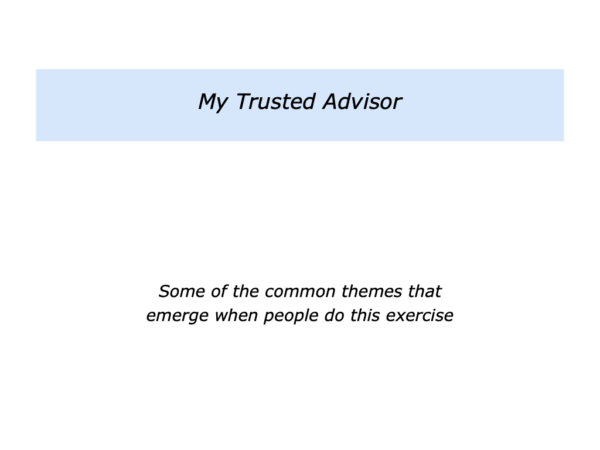
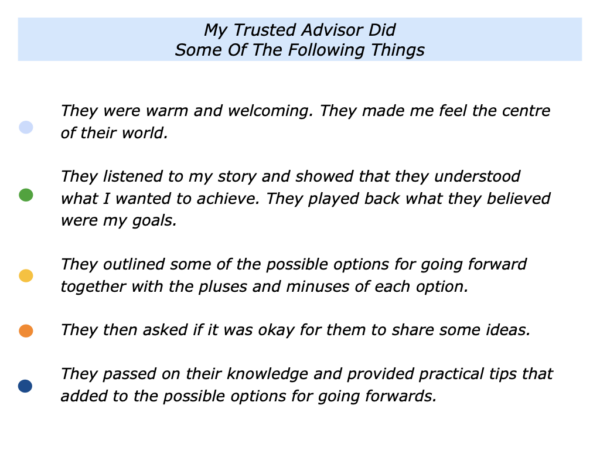
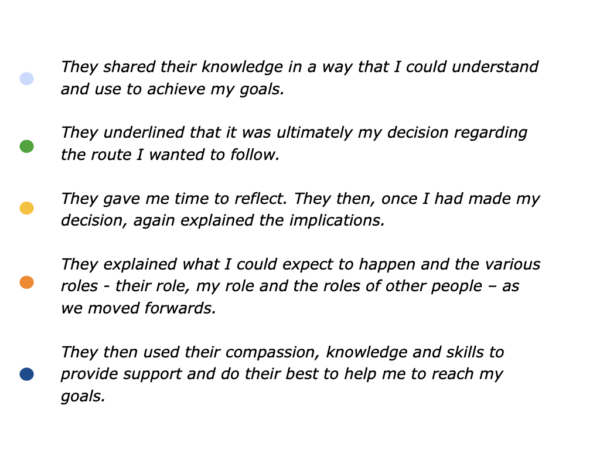
Building On Your Strengths
As A Trusted Advisor
Before meeting with a person, it can be useful to clarify your strengths as a trusted advisor. Different advisors have different areas of expertise, so it can be useful to know what you can offer to people.
You may be good at helping people by passing on knowledge, strategies or practical tools. You may be good at creative problem solving, providing technical solutions or helping people in other ways.
It can also be useful to clarify your organisation’s strengths. You may then be able to involve other people in the organisation who can provide these things to help clients. If you wish, try tackling the exercise on these themes.

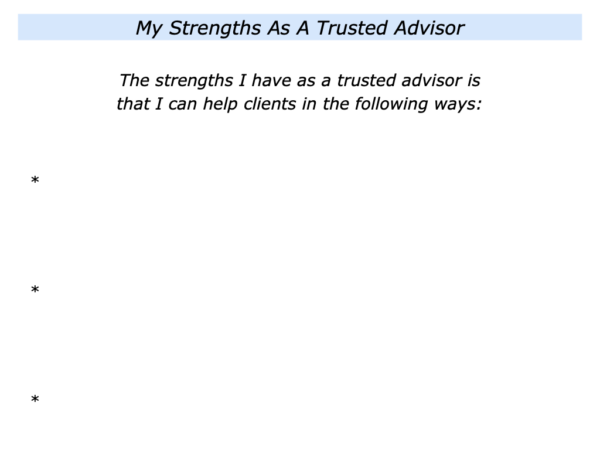
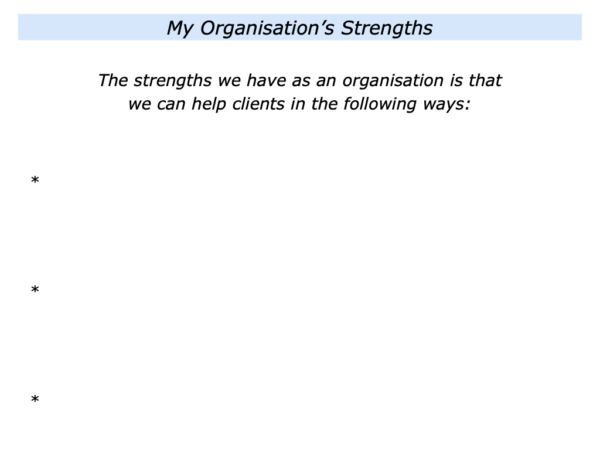
Trusted Advisors Prepare
Properly For The Session
The following section provides a framework that you can use to prepare for the session. It focuses on: a) How you can understand the person you are going to meet; b) How you can help them to achieve their picture of success.
This exercise invites you to do the following things to increase the chances of running a successful session. It asks you:
To clarify what you know about the person and what is happening in their world;
To clarify the topics the person may want to explore;
To clarify how you and your organisation can help them to achieve success;
To clarify the actual words you would like the person to be saying after the session;
To clarify how you can do your best to ensure they are saying these things.
This is a key exercise that I use on the workshops. People spend around 20 minutes completing the written part of the exercise. They then share their ideas with others in the group.
People say that they find it extremely useful. Some have introduced it throughout their organisations to ensure their staff prepare properly for meetings with clients.
The following section starts with some of the questions the trusted advisor can ask themselves before meeting a person. This helps to ensure they understand the person and what may be happening in their world.

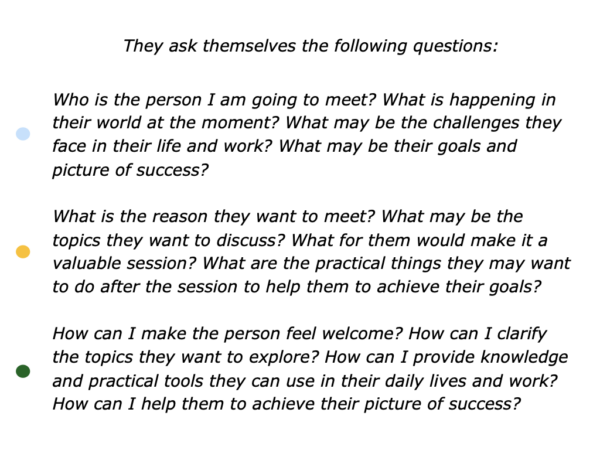
Imagine that you have answered some of these questions. You can then move on to completing the following exercise.
Write the name of the actual person you are going to meet and work through the following steps. Trusted advisors often do this before meeting each of their clients because it increases the chances of achieving success.
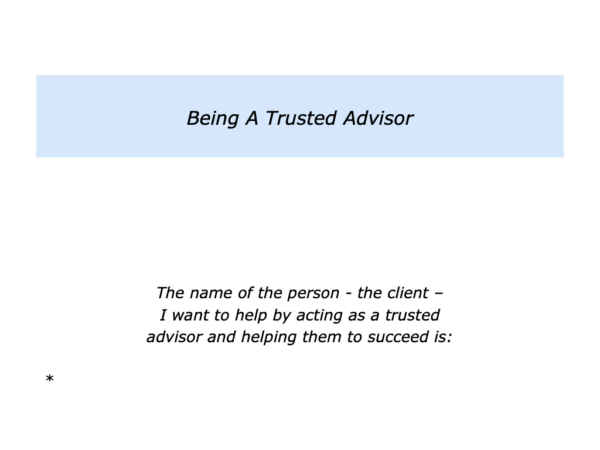
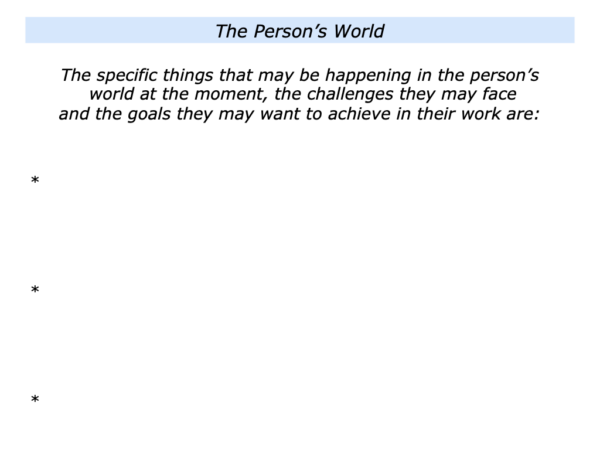
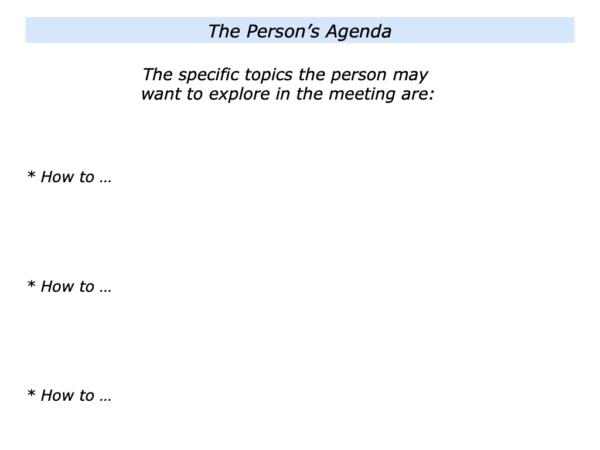
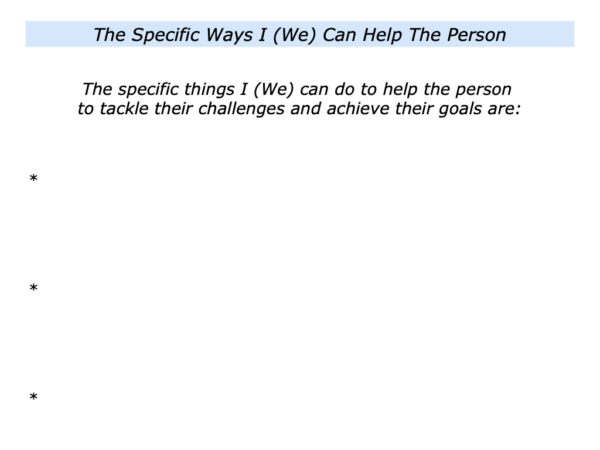

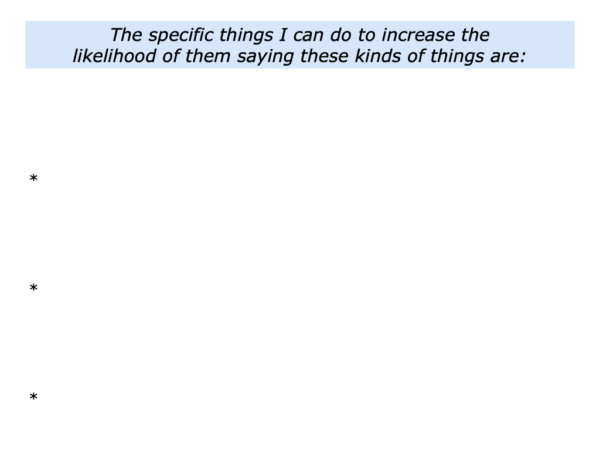
Trusted Advisors Follow Their Chosen
Model For Running A Successful Session
Different trusted advisors have different areas of expertise. They also follow their chosen model for running a session. One common factor, however, is that they often rehearse a session.
They rehearse welcoming the person, creating an encouraging environment and helping the person to feel at ease;
They rehearse clarifying the topics that the person wants to explore and agreeing the goals for the session;
They rehearse exploring the various topics and, when appropriate, passing on knowledge and practical tools the person can use to achieve their goals;
They rehearse any possible challenges or unexpected things that might happen in the session and how to help the person in these situations;
They rehearse checking with the person that everything has been covered and doing whatever is required to run a successful session.
The following section outlines one approach to running a session. You will, of course, have your own approach.
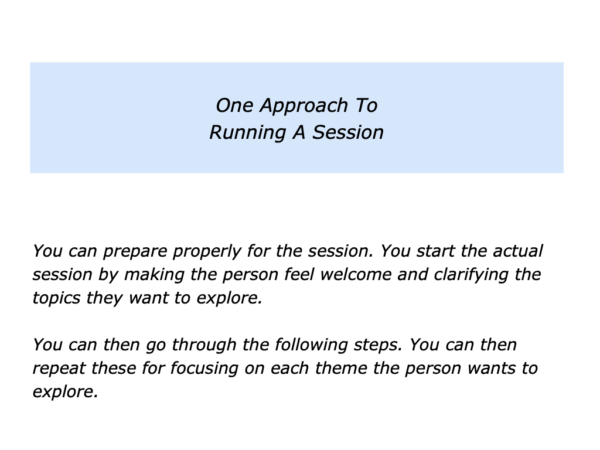
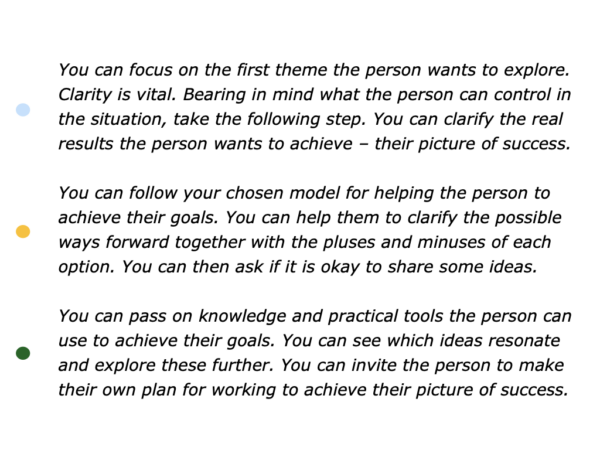
Trusted Advisors Sometimes Follow Elements
Of The Three C Model For Helping A
Person To Achieve Their Picture Of Success
You will have your own approach to helping a person to achieve their goals. One approach is to use the Three C Model that focuses on clarity, creativity and concrete results.
Clarity is crucial. Sometimes a person comes with specific problem they want fixed and it important to deal with this issue. At the same time, however, it is vital to clarify the real results a person wants to achieve.
You will do this in your own way but one approach is to clarify the person’s short and longer-term goals. Bearing in mind what the person can control in the situation, you can help to clarify the real results the person wants to achieve. Here are some examples.
Person A originally said:
How can we fix an immediate problem with a difficult customer? They have hired us to do work that doesn’t play to our strengths and they make life miserable for our people. What can we do?
Person A settled on two things:
How can we fix the immediate problem in a way that is, as far as possible, a win for the customer and a win for our company? How can we also build strategic relationships with the kinds of customers with whom we work best – because this is the way forwards for our company?
Person B originally said:
How can I as a leader understand and motivate the talented but difficult people in my team?
Person B settled on:
How can I build a successful team? How can I do this by creating a positive environment in which self-motivated people can achieve peak performance?
Person C originally said:
How can I deal with my manager who insists on micro-managing me every day?
Person C settled on two things:
How can I deal with the present situation by behaving professionally towards my manager and delivering positive results? How can find a rewarding role where I work with a manager whom I respect?
Sometimes the person has many issues they want to tackle. If so, can be useful to list these in order of priority and then focus on the first theme.
As mentioned earlier, it is important to clarify what the person can control in the situation. Bearing this in mind, imagine that you are clear on the real results the person wants to achieve. You can then help them:
To clarify the possible options for going forwards;
To clarify the pluses and minuses of each route;
To clarify the attractiveness of each option.
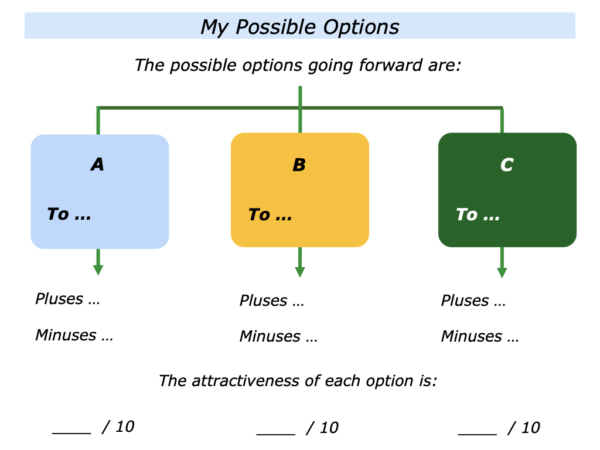
Keep going until you have explored the obvious routes forward. If appropriate, you can then ask the person if it is okay for you to share other potential solutions.
It is important to get the person’s psychological permission that it is okay to share ideas. You can then pass on knowledge, strategies and practical tools that can help the person to achieve their goals. Look for the ideas that resonate with the person and explore these further.
At a certain point it may be appropriate to invite the person to settle on their chosen way forward. You can encourage them to focus on the key strategies they can follow to give themselves the greatest chance of success. They can then settle on an action plan that they believe in.
You can move on to the next theme the person wants to explore. Here is an overview of the Three C Model.
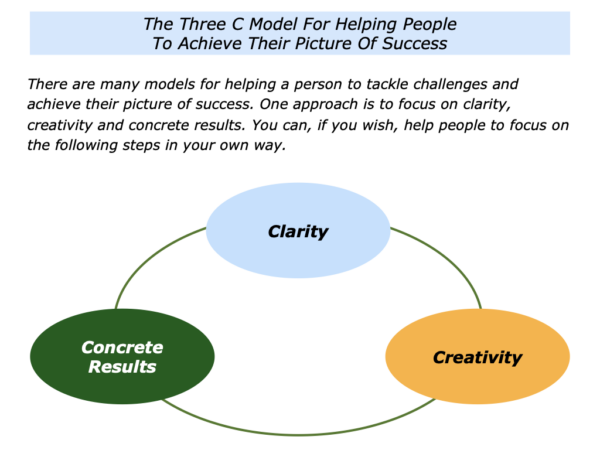
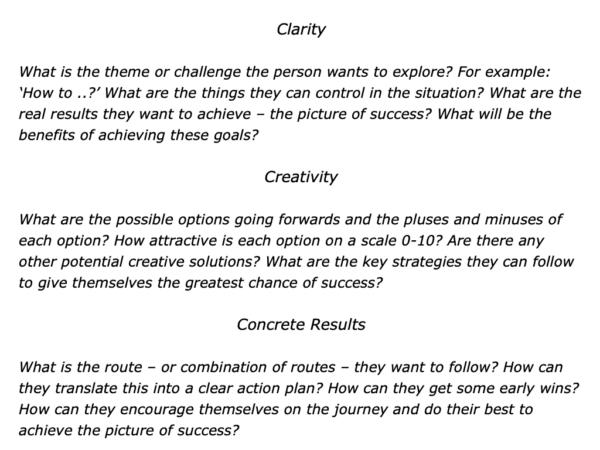
Continuing To Develop
As A Trusted Advisor
There are many ways to help people. This article has explored how trusted advisors can pass on knowledge to help people to achieve their picture of success.
Trusted advisors are committed to the ethic of constant improvement. Bearing this in mind, here is one final exercise. Looking are your work at a trusted advisor, this invites you to do the following things.
Describe how you can keep building on your strengths.
Describe how you can tackle any areas for improvement.
Describe your specific action plan for continuing to develop.
Take the ideas you like from this article and use them in your own way. Here is the exercise on this theme.
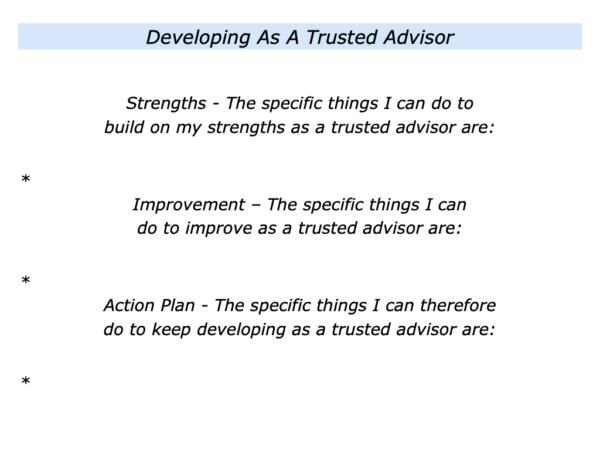






Leave a Reply